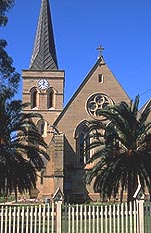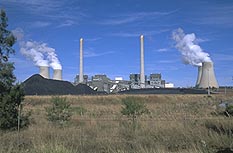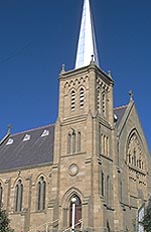
|
| St Alban's Church of
England, Muswellbrook |
Muswellbrook
Interesting historic town in the Hunter Valley
Muswellbrook is a substantial and very attractive country
town of historic buildings and tree-lined streets situated
beside the Hunter River, 257 km north of Sydney, 26 km south
of Scone and 144 metres above sea-level. It is an expanding
centre due to the employment opportunities provided by the
eight coalmines in the district, the presence of the Liddell
and Bayswater Power Stations and a flourishing wine grape
industry. Thus the population of the shire increased from
less than 8000 in 1976 to around 16 000 by 1997 with 26 per
cent of the workforce employed in the mining, electricity,
gas and water sectors in 1991. Muswellbrook also continues
to fulfill its role as a service centre to the dairying and
agricultural activities of the countryside which still
supports a large number of horse studs.
The area was once occupied by the Wanaruah Aboriginal
people and possibly the Kamilaroi. Certainly the two tribes
had trade and ceremonial links. The Wanaruah favoured
goannas as a food source, covering larger animals in hot
ashes and stuffing them with grass. They also adopted
burning off practices as the new shoots which emerged after
fire attracted kangaroos which they surrounded and killed
with clubs and spears (du-rane) barbed with sharp stones.
They also used stone axes (mogo) made of hard volcanic rock
bound to a wooden handle.
The Kamilaroi tribe was subdivided into clans and classes
which determined marital possibilities (girls being often
betrothed in infancy and married by about 14). They wore
opossum clothing and, for ceremonial or ornamental purposes,
smeared themselves with red ochre and pipe clay, scarred
their bodies and wore decorative headwear. Once one of the
largest linguistic communities in Australia their last known
formal communal ceremony was held in 1905.
European settlement followed in the wake of John Howe's
expedition to the Singleton district in 1820 and Henry
Dangar's pursuit of the Hunter further north in 1824. That
year Dangar reserved a village site at the junction of the
Hunter and the creek at the southern end of the present
townsite which he named Muscle Brook due to the large
numbers of mussel shells he found on its banks (at the time
'muscle' was an accepted alternative spelling of mussel).
The first Chief Justice of NSW, Francis Forbes, an
important figure in early colonial judicial history, was
granted the land which now constitutes South Muswellbrook in
1825. He named his estate 'Skellater' after the family's
ancestral estate in Aberdeen in Scotland.
A township was laid out and gazetted in 1833 as
Musclebrook with the first allotments sold the following
year (the very first block is now occupied by the Royal
Hotel). The first post office was established in 1837 and
that year, when Edward Denny Day was made first police
magistrate of the district, a mounted police force, police
barracks and courthouse were established.
For nearly sixty years the town's name was spelled in
every way imaginable. Musclebrook, Muscle Brook,
Muswellbrook, Muswell Brook, Muscletown and Musswellbrook
were all employed. Day appears to have been the first to
change the spelling of the town from Muscle Brook to Muswell
Brook. It was only at the end of the 1880s that
'Muswellbrook' was consistently employed although it was not
officially gazetted as such until 1949.
By 1840 the population was 215. There were 41 houses as
well as some inns and shops. A flour mill was built around
1841, reflecting the fact that wheat, along with wool, was
the centrepiece of the local economy.
In 1842 the sons of Francis Forbes established the
private village of Forbestown south of Muscle Creek but due
to confusion with the town of Forbes it was changed to South
Muswellbrook in 1848.
When the railway arrived in 1869 it boosted the local
economy as the settlement became the northern railhead and
the population climbed to about 1500. However, when this
advantage passed on to Scone the town shrunk again.

|
| Bayswater Power Station
between Singleton and Muswellbrook
|
When Muswellbrook was declared a municipality in 1870 the
population was 1445. Coalmining began in the 1890s although
truly large-scale coal mining didn't get under way until
more recently. There are now eight mines operating in the
area (seven of them open-cut) with another six proposed.
After the First World War the larger properties were
broken up into smaller farms with dairying supplanting wool
and wheat.
Writer Donald Horne, author of The Lucky Country, was
raised in Muswellbrook and wrote of his experiences in The
Education of Young Donald (1967).
The town's Agricultural Show is held in April and the
Spring Wine Festival in October. The Muswellbrook Cup is
held on Melbourne Cup Day.
Things to see:
![[Top of page]](smlArrow.gif)
Tourist Information
The town's newly opened Tourist Information Centre is
located at 87 Hill St. To get there drive north along Bridge
St (the highway) and turn left into Hill St. A heritage walk
brochure is available along with general information about
the area. Enquiries about visits to the many local horse
studs should be directed here.
HERITAGE WALK
Loxton House
The tourist information centre is located behind Loxton
House which was built in the mid-1840s as a shop for Thomas
Kerr. Later it became a residential site. During this period
a Mr Hutchinson hanged himself in the cellars. The building
is now used for offices and shops with a restaurant at the
rear where there are modern additions.
Bridge St - North
Head north along Bridge St. The two-storey stone and brick
building at the St Vincent's centre was erected in the 1850s
for an ex-convict employee of the St Heliers Estate named
John Maddy. Carl Brecht, a German settler who planted the
first vineyard of the Upper Hunter in 1864 on his Rosemount
Estate (see entry on Denman), established stone wine cellars to the rear of
the building in 1882, setting himself up as a spirit and
wine merchant. Subsequently a cordial factory and bakery,
the building has undergone many changes.
Just past it is Eatons Hotel, a lovely old two-storey
building with roundheaded French windows and an enormous
verandah featuring fluted cast-iron columns and decorative
lacework supported at ground level by squared timber posts.
The White Hart Hotel, licensed by Ann Ward, was built on
this spot in 1839. It was replaced by the present building
in 1873. A tribute to its antiquity is the opening beside
the main entrance which was designed to allow access to the
stables at the rear. Additions were made in 1866 and 1929.
Forbes Flats is a nice old sandstock rubble building on the
Wilkins St corner, also dating from the 1850s.
Further north by the corner of Bridge and Wilkins Sts is
'The Old Tea House', a cafe and craft shop. This building
was erected as a residence by local stonemason J.H. Wilkins
in the 1870s. It was later named 'Kildonan' after the vessel
which returned the Wilkins brothers from World War I.
Additions were made in the 1910s and in 1940.
Hill St (Presbyterian Complex)
Return southwards along Bridge Cross turning left into Hill
St. To the left is St John's Presbyterian Church, designed
by W.L. Pender and erected 1913-15, with an arched lancet
doorway , a fine cedar door, an impressive spire and a
beautiful interior, especially the roof, organ and pulpit.
The headstones of early Presbyterian settlers John and Janet
Ferguson, who died in 1843 and 1851 respectively, are built
into a nook on the western side of the church.
The next building on the left is an earlier St John's,
erected in 1843. The Reverend John Dunmore Lang, a
significant figure in colonial church history, preached here
in 1850. It is now a Sunday School Hall.
Further up the hill, at the corner with Sowerby St, is
the former Presbyterian manse, designed by John Pender and
built of brick and iron with gables in 1876-77. The verandah
has French doors and some attractive decoration around the
columns. It is now a private residence.
On the other side of Sowerby St, with a sandstone rubble
fence, is the former hospital, a very fine building erected
in 1864 with 1880s additions attributed to J. Horbury Hunt.

|
| St James Catholic Church,
Muswellbrook |
Catholic Precinct
Turn south down Sowerby St and take the first right into
Brook St where you will find the Catholic precinct. The
first Catholic church was erected on this site in 1861. The
present St James, with its attractive belltower, dates from
1911. Parts of the school date back to the 1880s and the
presbytery to 1896.
Bridge St - South
Continue down Brook St to the intersection with Bridge St.
The south-eastern corner is known as Campbell's Corner. This
was the base of James Campbell's operations in the Hunter
Valley where he owned a chain of stores. Now Franklin's and
Matthew's Jewellers the first section of this building was
opened in 1870 with later additions. The clock tower was
added in 1911.
Turn left heading south along Bridge St. To the left are
the post office (1885) which stands in front of the old
telegraph office (1861). Next door is the old School of Arts
(1871, extended 1913). It is now the town hall building. On
the first floor is the Muswellbrook Regional Gallery which
features a large mural by a local artist, open Tuesdays to
Fridays from 10.00 a.m. - 5.00 p.m. or by appointment, tel:
(02) 6543 3984.
Over the road, occupying the first town allotment ever
sold (in 1834) is the Royal Hotel (1893). There have been
licensed premises on the site since 1835.
William Street
Turn left into William St past the piazza. To the left is
the single-storey brick police station (c.1868) with stone
sills and a well-preserved interior.
Market Street
Return back along William St taking the left into Market St
before reaching Bridge St. The park to the right is Simpson
Park, established in 1874 and featuring trees supplied by
the Royal Botanical Gardens of Sydney in 1876.
Further down Market St is the small brick railway
station, regarded as typical of its day. Built in 1869 it
was opened by the Earl of Belmore. The arrival of the train
line was a boon to the local economy as Muswellbrook became,
for a time, the northern railhead. A coach service connected
the station with a coach service which headed through
Denman, Merriwa and Cassilis.
Opposite is the Railway Hotel (c.1882) which became a
cordial factory later in the 19th century.

Broadwalk
Business Brokers
Broadwalk Business
Brokers specialise in General Businesses for Sale, Caravan Parks for
Sale, Motels for Sale, Management Rights & Resorts for Sale, Farms for
Sale, Hotels for sale,Commercial & Industrial Properties for Sale.
Phone:
1300 136 559
Email:
enquiries@broadwalkbusinessbrokers.com.au
AUSTRALIAN BUSINESSES FOR SALE
COFFS HARBOUR BUSINESS BROKERS
BROADWALK BUSINESS BROKERS
GOLD COAST BUSINESSES FOR SALE
BRISBANE BUSINESSES FOR SALE
SYDNEY BUSINESSES FOR SALE
CARAVAN PARKS FOR SALE
BUSINESSES FOR SALE
MOTELS
FOR SALE
HOTELS
FOR SALE
Disclaimer
We advise prospective purchasers that we take no
responsibility for the accuracy of any information in the business
provided by vendors or their professional advisers and that they should
make their own enquiries as to the accuracy of this information,
including obtaining independent legal and/or accounting advice
Muswellbrook

